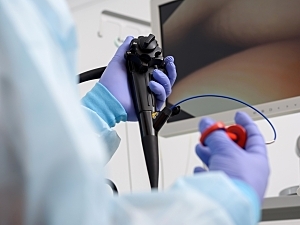POSE (primary obesity surgery, endoluminal) is an endoscopic, incisionless bariatric therapy that involves placing plications in the fundus to reduce gastric volume. Plication refers to approximating tissue in a serosa-to-serosa fashion rather than mucosa-to-mucosa as with suturing.
In 2018, Pichamol Jirapinyo, MD, MPH, associate director of bariatric endoscopy in the Division of Gastroenterology, Hepatology, and Endoscopy at Brigham and Women’s Hospital, and Christopher C. Thompson, MD, director of endoscopy and co-director of the Center for Weight Management and Wellness, developed a modified technique they call distal POSE. As they explained in VideoGIE, distal POSE involves placing plications primarily in the gastric body, sparing the fundus. Dr. Jirapinyo and Dr. Thompson have now published a one-year prospective registry study in Gastrointestinal Endoscopy, concluding distal POSE appears safe and effective for treating obesity and related comorbidities.
Methods
During distal POSE, plications are oriented in a “belt-and-suspenders pattern” along the width and length of the stomach to reduce its diameter and length, respectively. During the study period, two variations were performed, usually with assistance from fellows:
- Single-helix plication (n=42, December 2017 to October 2020)—Utilizes one G-lix (a channel of the endoscope) to obtain a single plication with serosa-to-serosa approximation with each activation of the Incisionless Operating Platform (IOP, USGI Medical, San Clemente, TX)
- Double-helix plication (n=68, November 2020 to December 2021)—Utilizes two G-lices to obtain two serosa-to-serosa plications with an internal mucosa-to-mucosa approximation with each activation of the IOP
All patients were offered moderate lifestyle intervention after the procedure, including routine follow-ups with the bariatric dietitian.
Primary Outcome
The primary outcome was the amount of weight loss one year after distal POSE:
- Mean total weight loss—16% (P<0.0001)
- Decrease in body mass index—From 38 kg/m2 at baseline to 32 kg/m2 (P<0.0001)
- ≥5% total weight loss—93% of the cohort
- ≥10% total weight loss—71% of the cohort
Comparison of Techniques
The mean number of plications was statistically similar for the two techniques (20 for single-helix and 22 for double-helix), but the double-helix technique was more efficacious:
- Reduction in gastric length—78% for double-helix approach vs. 65% for single-helix approach (P<0.0001)
- ≥10% total weight loss at one year—95% vs. 58% (P=0.03)
In multivariable analysis, the double-helix technique remained a significant predictor of greater weight loss at one year.
Secondary Outcomes
Following distal POSE, there were significant improvements in systolic and diastolic blood pressure, hemoglobin A1c, insulin resistance, and liver enzymes, both overall and among patients with abnormal baseline values.
Adverse Events
Overall rates of adverse events were:
- Mild—18% of patients needed hospital admission for ≤3 nights (17 cases of post-procedural nausea and vomiting, one of severe abdominal pain, one of hyperglycemia in a patient with insulin-dependent diabetes, and one of urinary retention requiring catheterization)
- Moderate—4% (one case each of sleeve stenosis requiring balloon dilation, hematemesis requiring endoscopy that revealed clean-based ulcers at the plication sites, pain from coronary artery vasospasm status post left-heart catheterization, and fluid collection requiring percutaneous drainage)
- Severe—0.9% (one patient had gastric perforation diagnosed on postoperative day 1, was treated with surgical closure, and was discharged home on postoperative day 4)
Rates did not differ significantly between the single- and double-helix techniques.
Potential Mechanism
By placing plications in the gastric body rather than the fundus, distal POSE may alter gastric motility more substantially than the traditional POSE procedure does. Further research will be needed to determine the mechanism.
